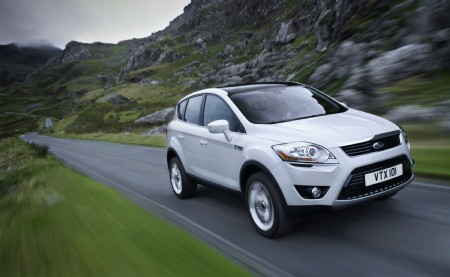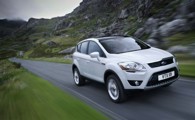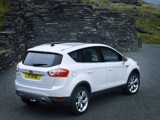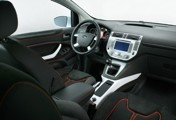Review
You really can’t fault Ford’s consistency, on two counts.
Firstly, if there’s a niche going strong, it will be years after everybody else has done it before the Blue Oval joins in with one of its own products.
Secondly, when Ford brings out new products these days, invariably they are of the very highest quality.
The new Ford Kuga pretty much ticks these two boxes.
So slow to market, it’s behind even the usually glacial decision-making process of Volkswagen, yet in nearly every way it oozes quality, style and sophistication.
Even the name is spot-on, sounding like chunky Lion King pup Simba’s younger brother, and reflecting its compact, muscular appearance.
Indeed, in a sector where looks and image are vitally important, Ford’s director of design Martin Smith has aced it with the Kuga, taking the four-square SUV proportions that attract families and imbuing it with little flourishes here and there that make it the best looking of its kind on the market in my eyes.
Then there’s the driving dynamics, which Ford reckons are class-leading, a solid dependable diesel engine, a wide range of lifestyle options and equipment, strong residual values and class-leading CO2 figures.
Before you ask, this isn’t an advertorial paid for out of Ford’s advertising budget, and I apologise if it sounds like one, but this really is a fantastic car.
Let’s temper things before it gets too sycophantic.
There are no door bins on the back doors, which is ridiculous.
And if it’s raining, water will disastrously leak on you through the split rear tailgate when it’s open.
Make sure your drivers understand these inadequacies before opting for three years of limited storage and wet-necked hell.
Ford has only 6,000-7,000 Kugas to sell in the UK annually, as production is limited.
That means there will be plenty of disappointed customers who didn’t act quickly enough.
Of those available, it is reckoned that around two-thirds will be retail sales.
I’d think this was utter tosh at the best of times – with the lowest CO2 in its class, priced at around £20,000 and made by the fleet industry’s largest manufacturer, I’d be amazed if only a third went to fleets.
But Ford has a bit of a thing about talking up its retail share at the moment, and it’s a message that is getting repeated often enough to make you think there’s a deliberate communication strategy going on.
Whatever the theory of the marketing, what are the 2,000 lucky company car drivers going to get with the Kuga?
Apart from the handsome appearance, the interior also feels well made, clear and functional without being dull, with enough space front and rear without being exceptional (it is built on the Focus platform, after all).
There are two trim levels – Zetec and Titanium – with the first starting at £20,500 and the higher model at £22,500.
The Zetec has interior colour styling cues inspired by trainers and sports bras, with flashes of blue or orange across the seats and doors.
The Titanium’s more low-key colour scheme works much better.
Specification is decent, with even the Zetec coming with
17-inch alloys, air conditioning, sports seats and trim, leather steering wheel, fog lamps, Quickclear windscreen, twin exhausts, ESP and Ford’s EasyFuel system to stop misfuelling.
There is only one choice of engine and gearbox at the moment – the 133bhp 2.0-litre Duratorq TDCi diesel with particulate filter and a six-speed manual gearbox.
This allows the Kuga to offer 169g/km of CO2 – the lowest figure in the SUV sector.
Towards the end of the year a 2.5-litre petrol and automatic option will arrive, but it seems that Ford has started off with the winning package straightaway.
Take-up should be small for those developments.
In Europe, a front-wheel drive model will be offered but so far there are no plans to bring it to the UK.
The already low CO2 figure would not be hugely improved and the market for two-wheel drive is restricted to the much cheaper, smaller Nissan Qashqai, so Ford doesn’t see the point in wasting effort on building and marketing a right-hand drive car of that type.
The combination of all this work looks like resulting in some seriously strong residual values that could well make the Kuga the market leader.
Early forecasts from CAP are for 47% over three years/60,000 miles, placing it above the Honda CR-V.
This makes it by far the best performer on Ford’s books, and a very competitive leasing product. It’s got user-chooser written all over it.
Behind the wheel
Ideal driving position.
Chunky steering wheel.
Short, fat gearlever.
Diesel engine thrumming away quietly. From minute one in the Kuga everything seems right.
Get it moving and the impression continues.
The engine is as quiet and refined in this car as it is in anything in the Ford range.
But the stand-out element for me is the ride quality.
The suspension and chassis architecture comes off the platform used by the Focus, which is a pretty useful starting point.
But it has so much more to contend with here, including a higher centre of gravity and more weight. It manages it superbly, with almost no body roll at all, yet this is not at the expense of ride quality, which is superb – firm, yet brilliantly damping out even the worst surfaces.
The steering feels like a very slightly less connected Focus, as it ought to, while the gearbox is precise and the engine pulls hard without ever becoming raucous, making it really enjoyable to drive.
The four-wheel drive system uses the Haldex coupling so beloved of the Volkswagen Group.
It provides drive to all four wheels electronically, though we didn’t get to try it off-road as days of torrential rain had rendered the tracks unusable.
No matter – this system has been proven to adequately pull a horsebox or boat and we did drive to a luxurious golf course, which is probably a more appropriate test of the Kuga’s ability anyway.
Verdict
Get your orders in early.
The Kuga is a superb car and will
fly off the shelves, with those 7,000 gone in no time. It may have taken Ford a while to get to market, but it was worth
the wait.



















